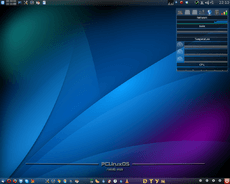PCLinuxOS facts for kids
 |
|

Screenshot of the PCLinuxOS KDE edition
|
|
| Company / developer | Bill Reynolds ("Texstar") |
|---|---|
| OS family | Unix-like |
| Working state | Current |
| Source model | Open source |
| Initial release | October 2003 |
| Latest stable release | 2013.04 / April 8, 2013 |
| Kernel type | Monolithic |
| Default user interface | KDE Plasma Desktop |
| License | Free software licenses (mainly GPL) |
| Official website | www.pclinuxos.com |
PCLinuxOS is a Linux operating system. It is a free operating system for personal computers. It was made to be easy to use.
Contents
History
The start of PCLinuxOS was a set of RPM packages created to improve successive versions of Mandrake Linux (now Mandriva Linux). These packages were created by Bill Reynolds, a packager better known as Texstar. From the year 2000 to 2003, Texstar maintained his repository of RPM packages in parallel with the PCLinuxOnline Web site. In an interview, Reynolds said he started PCLinuxOS "to provide an outlet for [his] crazy desire to package source code without having to deal with egos, arrogance and politics."
In 2003 Texstar created a fork of Mandrake Linux 9.2 (which was released in October 2003). Working closely with The Live CD Project, Texstar has since developed that fork independently into a full-fledged distribution. The initial releases were successively numbered as "previews" i.e. p5, p7, p8 up to p81a, then p9, p91, p92.
In August 2006 three new CDs/ISOs, numbered 0.93a, were released: MiniMe, Junior and Big Daddy. At the same time, the original packages that make up the KDE desktop environment have been split into smaller ones, while some less essential portions of KDE have been omitted from the CD. As a result, Texstar was able to fit the OpenOffice.org package into the BigDaddy release. MiniMe remains a minimal "Live & Install" CD for experienced users wishing to add their own selection of packages, while Junior adds a few essential desktop-oriented packages, meeting the user somewhere between the two other releases. PCLinuxOS 2008 "MiniMe" edition, was released on 2008-01-07.
With the advent of PCLinuxOS 2007, also known as .94, PCLinuxOS became rebased on Mandriva Linux 2007. This implied a shift to a more modern code which will require a complete reinstall to this version. The new version features a new look, and built-in 3D effects. Both Beryl and Compiz come pre-installed, and can be configured with the PCLOS Control Center. A new logo has also been designed for the new version, and is incorporated in the boot screen. A new login screen has been designed, entitled "Dark". PCLinuxOS 2007 final version was released on 2007-05-21.
GNOME edition
PCLinuxOS Gnome 2008, a remastered, community edition of PCLinuxOS featuring the GNOME 2.21.2 desktop (and sporting a look similar to Microsoft's Windows Vista), was released on March 21, 2008, and is currently hosted at linuxgator.org.
Features
PCLinuxOS is distributed as a Live CD, which can also be installed to a local hard disk drive. When used as a Live CD, it can work with a USB flash drive, where the user's configuration and personal data are saved. The entire CD can be copied to and run from memory (if the system has sufficient RAM) increasing speed. PCLinuxOS uses the Advanced Packaging Tool (or APT), a package management system (originally from the Debian distribution), together with Synaptic Package Manager, a GUI front end to APT, in order to add, remove or update packages. If there is enough memory on the machine and a network connection, the Live CD can update packages. PCLinuxOS is also designed to be easy to remaster after installation, creating one's own personalized CD, using the mklivecd tool.
Relationship with Mandriva Linux
Although it retains a similar "look and feel" to Mandriva Linux, PCLinuxOS has diverged significantly. The code was officially forked into an independent project in 2003, but after three years of contiguous development, the devs took advantage of further development in (the renamed) Mandriva, and forked the code again for PCLinuxOS 2007.
PCLinuxOS maintains its own software repository, available via the Advanced Packaging Tool (APT) and its Synaptic front-end, completely replacing Mandriva's urpmi. PCLinuxOS endeavors to maintain a fully valid upgrade path for version 1.0. This means that an installation could be continuously updated to the latest versions of packages, hence foregoing the need to re-install the entire distribution upon each successive release. In the test releases before 1.0, it has sometimes been necessary to perform a reinstallation.
Other differences include its own menu arrangement and custom graphics and icon sets.
PCLinuxOS places specific emphasis on desktop computing, concentrating its efforts for home or small business environments, hence paying less attention to other more "traditional" uses, like servers (although packages for most server tasks are available).
Projects
There are several community projects associated with PCLinuxOS. Since PCLOS includes the mklivecd script, there are several third-party distributions based on PCLOS. Some include:
- VideoLinux
- SAM Linux
The PCLinuxOS Magazine project is a community driven free publication focused on the users of PCLinuxOS by MyPCLinuxOS.com. This online publication was started in September 2006 by a group of PCLOS users with some publication experience. All content for the publication is solicited from the PCLOS user base.
The PCLinuxOS beautification project encourages and hosts user submitted media for visual aspects of PCLinuxos.
All the above projects are tracked and have forums on the larger MyPCLinuxOS, whose stated purpose is to be "the home site of all community projects related to PCLinuxOS", and offers help and support "whether you're looking to start a project,[or] join a project"
Related pages
See also
 In Spanish: PCLinuxOS para niños
In Spanish: PCLinuxOS para niños

